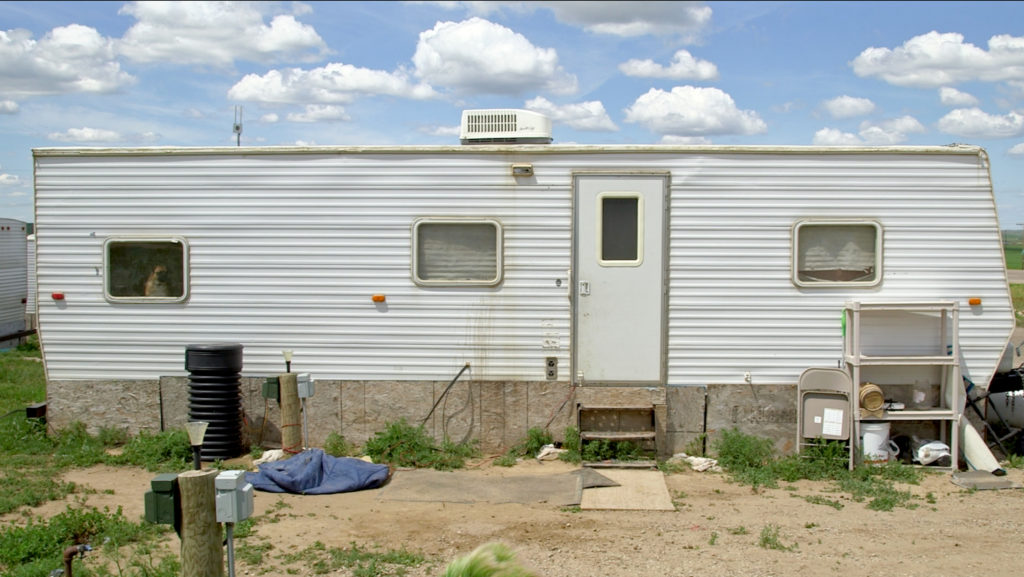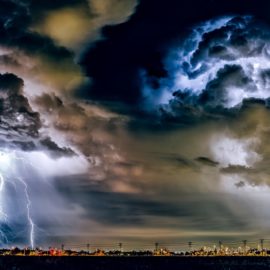
Is this what you would want to live in? A true FEMA trailer? Is there a better option for disaster victims who have lost their homes? Maybe.
The two houses next to each other in north Lake Charles, with their spacious porches framed by wood railings, don’t stand out much. They appear well-kept and inviting. The average person might never know they were built in a factory. The three-bedroom modular structures were put in place in the years after Hurricane Rita struck Louisiana in 2005 as part of a program for post-disaster housing. They held up well in the 2020 hurricanes that devastated southwest Louisiana, and they could serve as an example as the region struggles to rebuild. “We still have a lot of people [who] are homeless,” said Santana Hogan, 31, who lives in one of the houses with her husband and daughter and has relatives still displaced in Lafayette. “Our house came out just fine. We were blessed: no real damage.”
theadvocate.com
These houses are a better than the trailers used subsequently in the years following. They do not survive storms and there were problems with some of them.
By contrast, the de facto temporary housing solution for those displaced by major disasters is the FEMA-supplied trailer, and the Lake Charles area is no exception in the wake of Hurricane Laura in August and Hurricane Delta six weeks later. But discussions about whether there could be a better and more sustainable way have been underway for years. Some envision a future of modular houses or tiny houses produced by pop-up factories rolled out rapidly to supply them, similar in some cases to what became known as Katrina cottages. Others have advocated solutions such as transforming shipping containers into small residences. Immense hurdles to such solutions and questions about affordability stand in the way, so the Federal Emergency Management Agency trailer is likely to remain the go-to option for some time. Indeed, a pilot program on alternative housing following Katrina and Rita was plagued by delays, cost issues and construction problems in certain cases, though the two Lake Charles modular houses appear to be serving their current occupants well.
Yet we should still look at other, more sustainable, options. Possibly homes that could be used in another capacity once the disaster residents get back into their homes.
Still, alternatives could and should gradually gain more attention and financing, particularly for longer-term housing, analysts say. “It’s always the scale issue that really affects any kind of pre-fabricated homes,” said Geoff Gjertson, an architecture professor at the University of Louisiana at Lafayette and director of its Building Institute. The institute’s designs include a solar house that won an award in a U.S. Department of Energy competition. “And unfortunately, it’s hard to get orders for that many homes. The government could do it. They could order 10,000 of them and then you would definitely see some competition and the costs coming down. But if it’s just a few here and there, it’s going to be hard to ever get a competitive cost for something that’s not only more sustainable but just more livable and a better quality of life than what you can have in a typical trailer.”
With our hurricanes, the FEMA trailers are a common sight in Louisiana reminding us of what could happen to all of us.
Rows of FEMA-supplied white trailers in recreational vehicle parks or on lots next to ruined houses in hard-hit neighborhoods have become a common post-hurricane sight in south Louisiana. In the months after Hurricane Katrina and the federal levee failures devastated New Orleans in 2005, they were both a blessing and a curse, providing a roof over the heads of tens of thousands of families but also posing health risks due to elevated levels of formaldehyde. FEMA says those issues have been resolved, and in the wake of Laura and Delta, households in southwest Louisiana have been supplied with travel trailers and mobile homes spread out at RV parks and on private property. Those living in them include a wide array of people, some whose apartments were destroyed and some homeowners without other options. After Katrina and Rita, FEMA says, it and the state supplied 85,000 Louisiana families with temporary housing. After Laura and Delta, some 2,156 households are currently in travel trailers and mobile homes, while 192 have moved out. Another 57 are waiting to move in.
Even with the trailers ready to go, assigning them the next step, moving people in is not always easy.
There have been delays in moving people into the trailers, and FEMA says those are mainly due to setting them up in a way that meets all regulations then arranging for inspections. Sites must also be located for families who do not own property, and that has sometimes been a challenge. Earlier this year, the Calcasieu Parish Police Jury rejected a proposal to turn a former golf course into a mobile home park. Delays have led to frustrations. Jonathan Fontenot’s house in Lake Charles was badly damaged by Laura, and he eventually qualified for a FEMA trailer. After it arrived however, it was locked and Fontenot was not authorized to enter before it was inspected. He could have roughed out the time in the small part of his house that remained livable. But electricity service had already been rerouted to the trailer, so he had to stay with friends. It ended up being a much longer wait than he anticipated. After about a month, Fontenot, a lawyer, grew so frustrated he told FEMA he would obtain an eviction notice to have the trailer removed from his property if someone didn’t arrive to inspect it and let him live there. The message was received, and Fontenot was able to move in soon afterward. It turned out to be a brief stay. On May 17, the trailer took on water in severe flooding that hit the Lake Charles area and had to be replaced. Fontenot, 55, is now living in the second trailer on his lot. His house has been razed, and he is planning to rebuild.
Despite these problems, there is gratitude that they are available and they do help the displaced families.
Despite the complications, Fontenot stressed that he is grateful for the trailer and glad FEMA could supply it. Like many working to rebuild, he said he appreciates any help and doesn’t want to be seen as criticizing those trying to assist. Asked about other possible solutions, such as a modular house, Fontenot said he would likely need to know more about how such a program would work. “I don’t have much experience with the modular buildings, but I think trailers are about the cheapest you can do anything,” he said.
Cheaper is not always the best option. But are modular homes any better?
Jarrod Goentzel, director of the Humanitarian Supply Chain Lab at the Massachusetts Institute of Technology, is ready to provide such information. The son of a general contractor, he has looked closely at post-disaster housing options while also seeking to combat misguided perceptions that modular houses – those built in factories and delivered – are of inferior quality to those constructed on site. A 2019 study he and other researchers carried out in collaboration with FEMA laid out some of the benefits and challenges of housing alternatives. A mix of housing options is necessary, he said, but Goentzel advocates more effort toward factory-built houses, pointing to other countries where they have become widespread. Expanding demand and scale in the United States, where the industry remains relatively small, would reduce costs and increase capacity. As one example, his team’s study discussed the possibility of pop-up factories deployed rapidly after disasters to manufacture them. “I think the opportunity is once you start thinking about doing something in a factory setting and standardizing it, there’s a way to make it more affordable,” Goentzel said. Ultimately, families could end up with houses that would be “better quality, more resilient to future storms and affordable to the communities that are often vulnerable in those settings.” The study estimated that deploying a trailer for 18 months costs an average of $110,000 to $129,000.
There are other factors that make trailers a better option. Factors that may change as years progress and we get a firmer handle on disaster preparedness.
A series of complications prevents any rapid move away from trailers. In the case of renters left homeless by storms, empty lots at affordable amounts would have to be found where a permanent or semi-permanent house could be placed. Other factors include restrictions on FEMA supplying what would be considered permanent housing and the need to match local building codes. FEMA trailers are meant to house families for no more than 18 months after a disaster declaration, and those living in them must provide updates on their search for a permanent solution. FEMA said that under current laws it would be allowed to use modular and other types of permanent housing in only a limited number of circumstances, such as when temporary housing is “unavailable, infeasible or not cost-effective.” “As a practical matter, this restriction limits FEMA’s ability to use modular homes in most situations,” the agency said. That’s because locations where modular houses can be supplied are also “feasible for more cost-effective forms of housing FEMA typically uses … such as manufactured homes and recreational vehicles.” The agency added: “Although FEMA is not currently exploring using factory-built and modular homes as part of its direct housing program, these types of homes may be useful solutions to housing shortages after disasters.”
Despite the FEMA position, some local disaster officials feel differently.
Nicole Miller, who oversees disaster housing for Calcasieu Parish, agrees that more modular and factory-built houses should be part of the mix. She was executive director of the Project Build A Future non-profit when it helped install the two modular houses in north Lake Charles. Despite wider issues related to the program, she said she thought the modular models in Lake Charles worked well. The organization subdivided one lot into two as part of efforts to bring down costs. The houses included hurricane-proof windows and hurricane strapping to strengthen the frames. “There have been companies that are already doing these small modular units that you could ship in quickly,” said Miller, explaining that they aren’t “a huge luxury unit, but it also can become a building block.” “You haul in a FEMA trailer, somebody lives there for a year. You’re pretty much bringing it to the dump after that – all the wasted material and costs that went into that,” she said.
This discussion needs to be continued as we do need to help those effected by hurricanes and other weather related damage. All parties need a say and none should rule out any option, at first.



